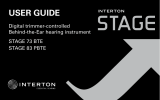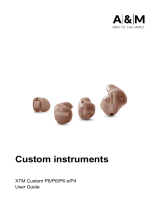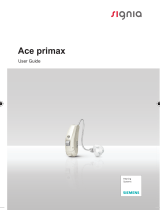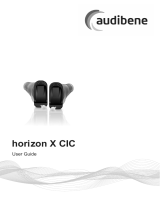Page is loading ...

NON WIRELESS
BEHIND-THE-EAR (BTE)
RECEIVER-IN-THE-EAR (RIE)
USER GUIDE
ReSound Vea
TM
ReSound Magna
TM

2
Introduction
Congratulations on the purchase of your new hearing instruments. ReSound’s innovative sound
technology and design, combined with the customized set-up selected by your hearing care
professional, will make hearing a more enjoyable experience. Hearing instruments will enable
you to hear sounds that you may not have heard in years because of your hearing loss. Practice
and a positive attitude are important in learning to use hearing instruments. Your ReSound instru-
ments have been adjusted according to your individual hearing loss and needs. Some people
adjust quickly to wearing hearing instruments in their ears and hearing new sounds; other
people may need more time.
Please read this manual carefully in order to wholly benefit from the use of your hearing instru-
ments. With proper care, maintenance, and usage, your hearing instruments will aid you in bet-
ter communication for many years. Ask your hearing care professional if you have any questions.
ReSound is a registred trade mark of GN ReSound A/S
Intended use
Generic air-conduction hearing instruments are wearable sound-amplifying devices intended to
compensate for impaired hearing. The fundamental operating principle of hearing instruments
is to receive, amplify, and transfer sound to the ear drum of a hearing impaired person.

3
Hearing instrument model:
Left serial number:
Receiver tube length:
Right serial number:
Tube type: Dome size:
Model VE60 VE62 VE70 VE77 VE80 VE88 MG90
Battery size 312 312 13 13 13 13 675
SYMBOLS
WARNING points out a situation that could lead to serious injuries,
i CAUTION indicates a situation that could lead to minor and moderate injuries.
i
Advice and tips on how to handle your hearing instrument better.

4
CONTENTS
Introduction ............................2
Description of the BTE
hearing instruments ......................6
Description of the RIE hearing instruments ....10
Getting started.........................12
SmartStart............................12
Battery door lock .......................13
Inserting/Replacing the battery.............13
Low battery indicator ....................14
Inserting/Removing hearing instruments ......14
Removal (custom earmolds) ...............16
Removal (domes) .......................16
Operation of the hearing instrument .........17
Telephone use .........................21
Telecoil (optional) .......................21
PhoneNow............................22
Tele-loop systems ......................24
Direct audio input (optional) ...............24
Connecting/Disconnecting audio boots ......25
Care and maintenance...................26
Daily maintenance ......................27
Maintenance for BTE hearing instruments ....27
Cleaning earmolds......................28
Cleaning thin tubes and domes ............28
How to apply domes ....................29
Standard domes .......................29
Tulip domes ...........................29
Maintenance for the RIE hearing instruments ..30
The receiver tube.......................30
Cleaning the receiver tubes and domes ......31
Cleaning RIE or molds ...................31
Changing wax guard for receiver tube .......32

5
How to apply domes ....................33
Temperature test, transport and
storage information .....................35
General precautions.....................35
General warnings.......................36
Battery warning information ...............37
Troubleshooting Guide ..................38
Troubleshooting Guide ..................40
Technical Data .........................42
Warranty and repairs ....................43

6
Description of the BTE
hearing instruments
VE360-DI
VE370-DVI, VE270-DVI, VE170-VI
VE380-DVI, VE280-DVI, VE180-VI
MG490-DVI, MG290-DVI
1. Program button
2. Battery compartment & On/Off switch
3. Sound outlet
4. Front microphone inlet
5. Back microphone inlet
6. Volume control (optional)
7. Direct audio input
8. Left/Right indicator
(Left=Blue/Right=Red)
9. Battery door lock
10. Model
11. Product name
12. Serial number
13. Battery door

6
1
5
4
3
2
10
7
8/9
11
12
13
4
7

8
Description of the BTE
hearing instruments
VE377-DVI, VE377-DVIO,VE388-DVI
1. Program button
2. Battery compartment & On/Off switch
3. Sound outlet
4. Front microphone inlet
5. Back microphone inlet
6. Volume control (optional)
7. Direct audio input
8. Left/Right indicator (Left=Blue/
Right=Red)
9. Battery lock (optional)
10. Model
11. Manufacturer
12. Serial number
13. Earhook
14. Earmold and tubing
15. Thin Tube
16. Domes/earmold
a. Open dome
b. Tulip-Dome
c. Custom earmold
17. Sports lock (optional)

6
1
5
4
3
2
8/9
10
7
8/9
11
12
15
16.a
14
13
16.c
16.b
17
9
Traditional fitting
(earmold and tube)
Open fitting
(Thin Tube and dome)

3
6
54
1211
10
Description of the RIE hearing instruments
VE362-DVIR
1. Receiver tube
2. Receiver Open Dome
3. Receiver Tulip Dome
4. Receiver Power Dome
5. RIE mold
6. Sports lock
7. Battery compartment
8. Receiver
9. Push button
10. Volume Control (optional)
11. NP receiver tube
12. HP receiver tube
13. Left/right indicator
14. Model, and serial number
15. Direct audio input

14
15
13
9, 10
1
8
2
7
11
62 model
(type MRIE)

12
Getting started
On/Off function
1. When the battery door is closed, the hearing instrument turns on,
and the default program will be activ ated.
2. To turn off the hearing instrument, open the battery door. Many
individuals can use their fingernail to pull it open.
i
Tip: Whenever the hearing instruments are not in use,
remember to turn them off to avoid unnecessary battery
consumption.
SmartStart
Hearing instruments can be turned on once you have placed them on your ears. If you prefer to
turn them on just prior to placing them on your ear, your hearing care professional can activate a
function called SmartStart.
This function will delay the time in which the hearing instruments turn on by ten seconds after the
battery compartment is closed. This reduces the risk that the hearing instruments will whistle while
you put them on. With SmartStart, a beep will be heard for each second of the delay period.

13
Battery door lock
Your hearing care professional can install a Left/Right side indicator (Blue=Left,
Red=Right), which can be used to lock the battery door. Once locked, the
instrument can only be turned off once the instrument is unlocked.
To lock the battery door:
1. Close the battery door
2. Using the battery door locking tool, slide the color marker to the right.
To unlock the battery door: Slide the color marker to the left.
Inserting/Replacing the battery
1. Open the battery door completely by using your fingernail.
2. Remove the used battery if present. Insert the new battery with the positive side
in the correct position. The battery door has a ‘+’ indicator to help determine the correct
insertion.
3. Always use new Zinc-Air batteries that have a minimum remaining shelf-life of 1 year.
4. Gently close the battery door.
i
Tip: When the hearing instruments are not in use for an extended period of time, remov-
ing the batteries may help prevent corrosion of the battery compartment, and ensure
that battery life is not shortened.
Unlock Lock

14
Low battery indicator
Your hearing care professional can set your hearing instrument to give an acoustical indica-
tion when the battery is reaching its end of life. The hearing instrument will reduce amplifica-
tion and emit a melody if battery power gets too low. This signal will recur every 5 minutes for
VE60/62/70/77/80/88 models, and every 15 minutes for MG90, until the hearing instrument
automatically switches off. It is recommended that you keep spare batteries on hand.
Inserting/Removing hearing instruments
Insertion (custom earmolds)
1. Hold the earmold between your thumb and index finger and position its
sound outlet in your ear canal.
2. Slide the earmold all the way into your ear with a gentle, twisting movement.
3. Turn the top part of the earmold gently backwards and forwards so that it
tucks behind the fold of skin above your ear canal.
4. Move the earmold up and down and gently press to ensure it is positioned
correctly in the ear. Opening and closing your mouth can ease insertion.
5. Make sure the hearing instrument is seated behind the ear.

15
By experimenting, an easier method may be discovered. With proper insertion, hearing instru-
ments should fit snugly but comfortably. If hearing instruments cause irritation of the ears, con-
tact your hearing care professional. Never attempt to modify the shape of the hearing instru-
ment, earmolds, or tubing yourself.
i
Tip: It may be helpful to pull your ear up and outward with your opposite hand during
insertion.
Insertion (domes)
1. Hold the thin tube where it bends, and gently push the dome into the ear canal. Push the
dome far enough into the ear canal so that the thin tube lies flush with the head.
2. It is important that the tube and the dome fit correctly into your ear.
3. When the dome is placed correctly, you should not be able to see the thin tube sticking out
when facing a mirror.
Note: You should never
attempt to bend or modify
the shape of the thin tube.

16
Removal (custom earmolds)
1. Hold a portion of your earmold towards the back of the ear.
2. Pull the earmold outward and simultaneously rotate the earmold forward.
3. Consult your hearing care professional if you have difficulties removing the hearing instru-
ment.
Removal (domes)
1. Hold the thin tube with your thumb and forefinger and pull the
tube outward.
2. Consult your hearing care professional if you have difficulties
removing the hearing instrument.

17
Operation of the hearing instrument
Volume control (in 70, 80, and 90 models)
The volume wheel has numbers on it from 1 to 4, with 4 being
the maximum volume setting. During the fitting of the hear-
ing instrument, your hearing care professional will select an
optimal volume setting for you. Please note the setting of that
particular level. To increase the volume with the instrument fit
to your ear, turn the volume control wheel up. To reduce the
volume, turn the wheel down.
Please note that your instrument has been fit by your hearing care professional and that your
hearing loss requires a certain amount of amplification. This will also affect how much you are
able to increase the volume on your instrument. If you want to go back to the default volume
setting, the volume control has to be set at 2.5 (between 2 and 3). If you prefer not to use the
volume wheel your hearing care professional can disable the volume control.

18
Sports lock
The Sports lock will be applied or adjusted by your hearing care professional.
Volume control (in 62, 77, 88 models)
The volume control will allow the volume of hearing instruments
to be increased or decreased.
1. To increase the volume, push the volume control up.
2. To decrease the volume, push the volume control down.
When volume is increased or decreased, a beep signal will be
heard for each incremental change. When the upper or lower
limits of the volume range are reached, a beep signal with a
longer duration will be heard.
Your hearing care professional can disable the volume control function if it is not desired. The
volume control can also be replaced with a non-functional cover.

19
Program button
Depending on your experience level with hearing instruments, in-
dividual hearing needs, and the type of listening environments you
experience, your hearing care professional may activate additional
programs. If additional programs have been activated, the follow-
ing list explains how they work.
1. You can switch between programs by pushing the program button once.
2. You will then hear one or more beeps. The number of beeps indicates which program you
have selected (one beep = program one, two beeps = program two, etc.).
3. When the hearing instruments are turned off and then back on, the hearing instrument
always returns to the default setting (program one).
The multifunction button (62 models only) is designed to change the volume or listening pro-
grams of the hearing instrument, based on different ways it is pressed.

20
If necessary, your hearing care professional can change these settings and fill in the following
table to indicate new settings
Multi-function button action Default setting New setting
Short press up Increases volume
Short press down Decreases volume
Long press up (3 seconds) Changes programs
Program Description of when to use
1
2
3
4
/





